Kai Puolamäki
Non-geodesically-convex optimization in the Wasserstein space
Jun 01, 2024Abstract:We study a class of optimization problems in the Wasserstein space (the space of probability measures) where the objective function is \emph{nonconvex} along generalized geodesics. When the regularization term is the negative entropy, the optimization problem becomes a sampling problem where it minimizes the Kullback-Leibler divergence between a probability measure (optimization variable) and a target probability measure whose logarithmic probability density is a nonconvex function. We derive multiple convergence insights for a novel {\em semi Forward-Backward Euler scheme} under several nonconvex (and possibly nonsmooth) regimes. Notably, the semi Forward-Backward Euler is just a slight modification of the Forward-Backward Euler whose convergence is -- to our knowledge -- still unknown in our very general non-geodesically-convex setting.
Gradient Boosting Mapping for Dimensionality Reduction and Feature Extraction
May 14, 2024Abstract:A fundamental problem in supervised learning is to find a good set of features or distance measures. If the new set of features is of lower dimensionality and can be obtained by a simple transformation of the original data, they can make the model understandable, reduce overfitting, and even help to detect distribution drift. We propose a supervised dimensionality reduction method Gradient Boosting Mapping (GBMAP), where the outputs of weak learners -- defined as one-layer perceptrons -- define the embedding. We show that the embedding coordinates provide better features for the supervised learning task, making simple linear models competitive with the state-of-the-art regressors and classifiers. We also use the embedding to find a principled distance measure between points. The features and distance measures automatically ignore directions irrelevant to the supervised learning task. We also show that we can reliably detect out-of-distribution data points with potentially large regression or classification errors. GBMAP is fast and works in seconds for dataset of million data points or hundreds of features. As a bonus, GBMAP provides a regression and classification performance comparable to the state-of-the-art supervised learning methods.
Using Slisemap to interpret physical data
Oct 24, 2023Abstract:Manifold visualisation techniques are commonly used to visualise high-dimensional datasets in physical sciences. In this paper we apply a recently introduced manifold visualisation method, called Slise, on datasets from physics and chemistry. Slisemap combines manifold visualisation with explainable artificial intelligence. Explainable artificial intelligence is used to investigate the decision processes of black box machine learning models and complex simulators. With Slisemap we find an embedding such that data items with similar local explanations are grouped together. Hence, Slisemap gives us an overview of the different behaviours of a black box model. This makes Slisemap into a supervised manifold visualisation method, where the patterns in the embedding reflect a target property. In this paper we show how Slisemap can be used and evaluated on physical data and that Slisemap is helpful in finding meaningful information on classification and regression models trained on these datasets.
SLISEMAP: Explainable Dimensionality Reduction
Jan 12, 2022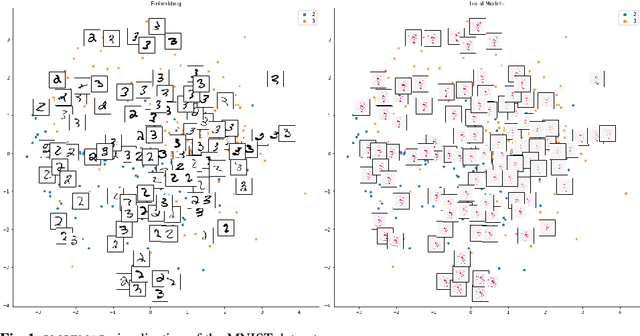
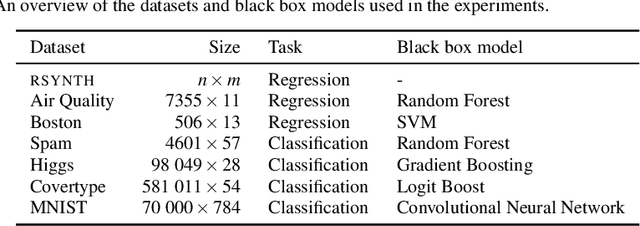
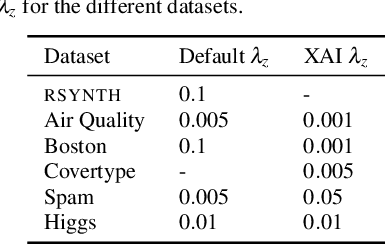
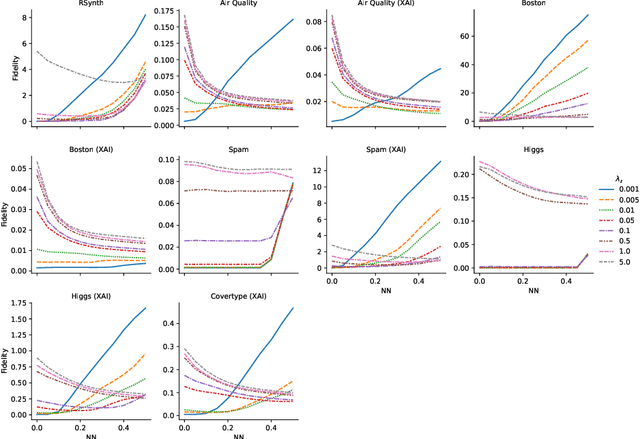
Abstract:Existing explanation methods for black-box supervised learning models generally work by building local models that explain the models behaviour for a particular data item. It is possible to make global explanations, but the explanations may have low fidelity for complex models. Most of the prior work on explainable models has been focused on classification problems, with less attention on regression. We propose a new manifold visualization method, SLISEMAP, that at the same time finds local explanations for all of the data items and builds a two-dimensional visualization of model space such that the data items explained by the same model are projected nearby. We provide an open source implementation of our methods, implemented by using GPU-optimized PyTorch library. SLISEMAP works both on classification and regression models. We compare SLISEMAP to most popular dimensionality reduction methods and some local explanation methods. We provide mathematical derivation of our problem and show that SLISEMAP provides fast and stable visualizations that can be used to explain and understand black box regression and classification models.
Interactive Causal Structure Discovery in Earth System Sciences
Jul 01, 2021
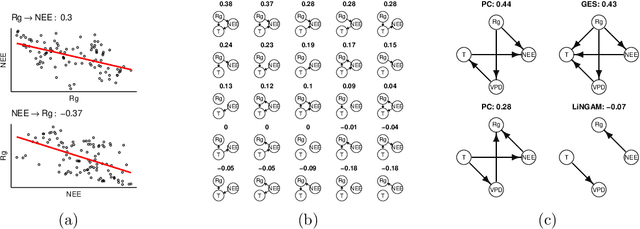
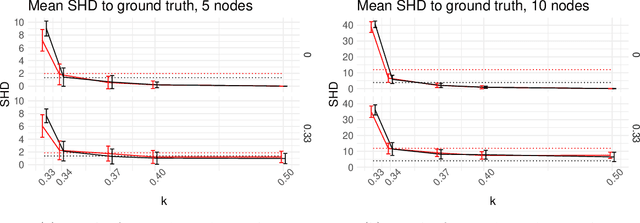
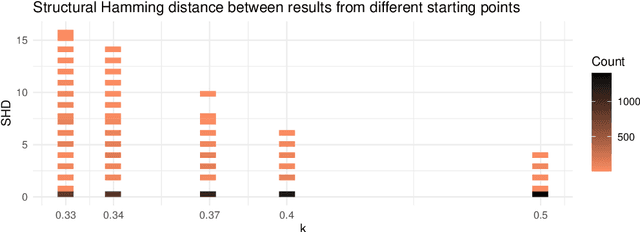
Abstract:Causal structure discovery (CSD) models are making inroads into several domains, including Earth system sciences. Their widespread adaptation is however hampered by the fact that the resulting models often do not take into account the domain knowledge of the experts and that it is often necessary to modify the resulting models iteratively. We present a workflow that is required to take this knowledge into account and to apply CSD algorithms in Earth system sciences. At the same time, we describe open research questions that still need to be addressed. We present a way to interactively modify the outputs of the CSD algorithms and argue that the user interaction can be modelled as a greedy finding of the local maximum-a-posteriori solution of the likelihood function, which is composed of the likelihood of the causal model and the prior distribution representing the knowledge of the expert user. We use a real-world data set for examples constructed in collaboration with our co-authors, who are the domain area experts. We show that finding maximally usable causal models in the Earth system sciences or other similar domains is a difficult task which contains many interesting open research questions. We argue that taking the domain knowledge into account has a substantial effect on the final causal models discovered.
Tell Me Something I Don't Know: Randomization Strategies for Iterative Data Mining
Jun 16, 2020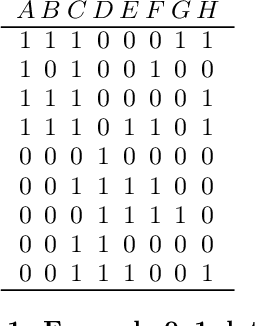

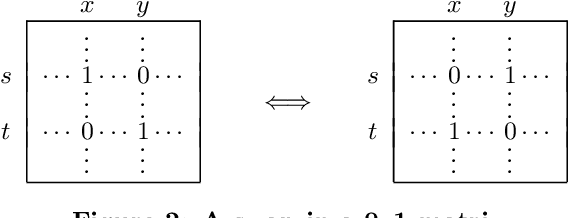
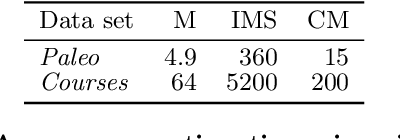
Abstract:There is a wide variety of data mining methods available, and it is generally useful in exploratory data analysis to use many different methods for the same dataset. This, however, leads to the problem of whether the results found by one method are a reflection of the phenomenon shown by the results of another method, or whether the results depict in some sense unrelated properties of the data. For example, using clustering can give indication of a clear cluster structure, and computing correlations between variables can show that there are many significant correlations in the data. However, it can be the case that the correlations are actually determined by the cluster structure. In this paper, we consider the problem of randomizing data so that previously discovered patterns or models are taken into account. The randomization methods can be used in iterative data mining. At each step in the data mining process, the randomization produces random samples from the set of data matrices satisfying the already discovered patterns or models. That is, given a data set and some statistics (e.g., cluster centers or co-occurrence counts) of the data, the randomization methods sample data sets having similar values of the given statistics as the original data set. We use Metropolis sampling based on local swaps to achieve this. We describe experiments on real data that demonstrate the usefulness of our approach. Our results indicate that in many cases, the results of, e.g., clustering actually imply the results of, say, frequent pattern discovery.
Low-Cost Outdoor Air Quality Monitoring and In-Field Sensor Calibration
Feb 05, 2020



Abstract:The significance of air pollution and problems associated with it is fueling deployments of air quality monitoring stations worldwide. The most common approach for air quality monitoring is to rely on environmental monitoring stations, which unfortunately are very expensive both to acquire and to maintain. Hence, environmental monitoring stations typically are deployed sparsely, resulting in limited spatial resolution for measurements. Recently, low-cost air quality sensors have emerged as an alternative that can improve granularity of monitoring. The use of low-cost air quality sensors, however, presents several challenges: they suffer from cross-sensitivities between different ambient pollutants; they can be affected by external factors such as traffic, weather changes, and human behavior; and their accuracy degrades over time. The accuracy of low-cost sensors can be improved through periodic re-calibration with particularly machine learning based calibration having shown great promise due to its capability to calibrate sensors in-field. In this article, we survey the rapidly growing research landscape of low-cost sensor technologies for air quality monitoring, and their calibration using machine learning techniques. We also identify open research challenges and present directions for future research.
Estimating regression errors without ground truth values
Oct 09, 2019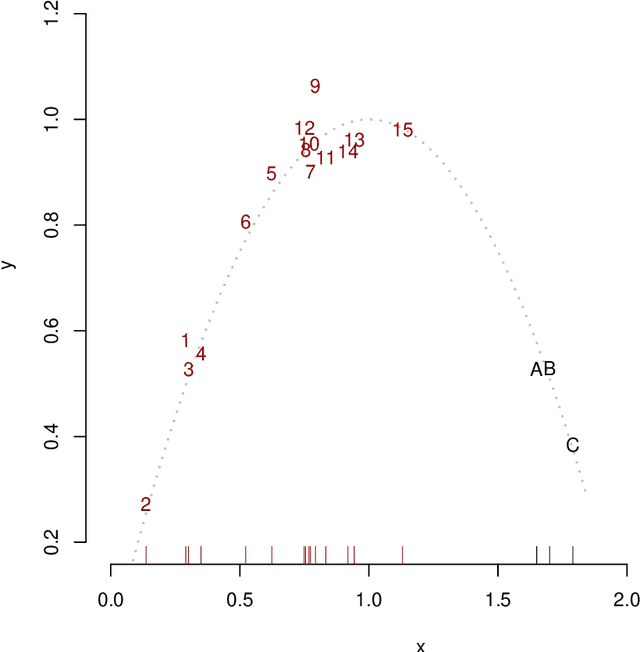
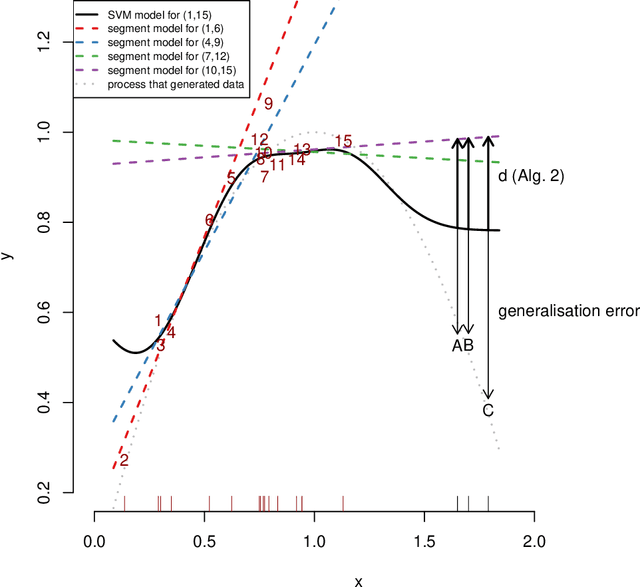
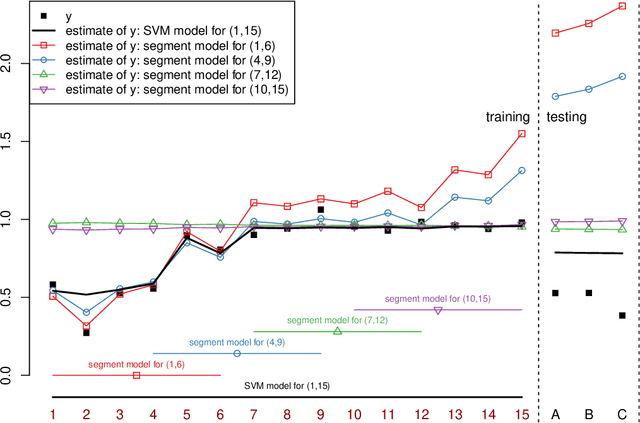

Abstract:Regression analysis is a standard supervised machine learning method used to model an outcome variable in terms of a set of predictor variables. In most real-world applications we do not know the true value of the outcome variable being predicted outside the training data, i.e., the ground truth is unknown. It is hence not straightforward to directly observe when the estimate from a model potentially is wrong, due to phenomena such as overfitting and concept drift. In this paper we present an efficient framework for estimating the generalization error of regression functions, applicable to any family of regression functions when the ground truth is unknown. We present a theoretical derivation of the framework and empirically evaluate its strengths and limitations. We find that it performs robustly and is useful for detecting concept drift in datasets in several real-world domains.
Guided Visual Exploration of Relations in Data Sets
May 07, 2019

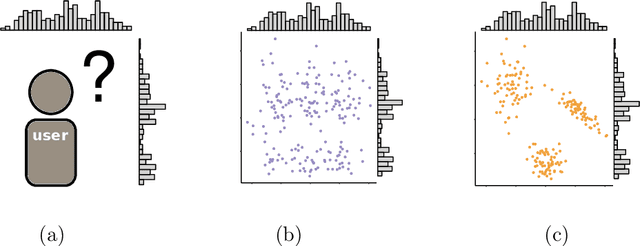
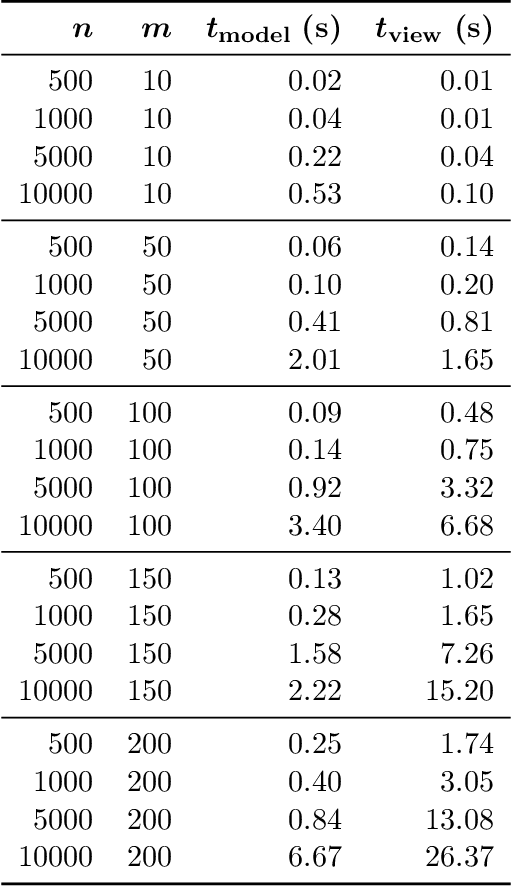
Abstract:Efficient explorative data analysis systems must take into account both what a user knows and wants to know. This paper proposes a principled framework for interactive visual exploration of relations in data, through views most informative given the user's current knowledge and objectives. The user can input pre-existing knowledge of relations in the data and also formulate specific exploration interests, then taken into account in the exploration. The idea is to steer the exploration process towards the interests of the user, instead of showing uninteresting or already known relations. The user's knowledge is modelled by a distribution over data sets parametrised by subsets of rows and columns of data, called tile constraints. We provide a computationally efficient implementation of this concept based on constrained randomisation. Furthermore, we describe a novel dimensionality reduction method for finding the views most informative to the user, which at the limit of no background knowledge and with generic objectives reduces to PCA. We show that the method is suitable for interactive use and robust to noise, outperforms standard projection pursuit visualisation methods, and gives understandable and useful results in analysis of real-world data. We have released an open-source implementation of the framework.
Human-guided data exploration using randomisation
May 20, 2018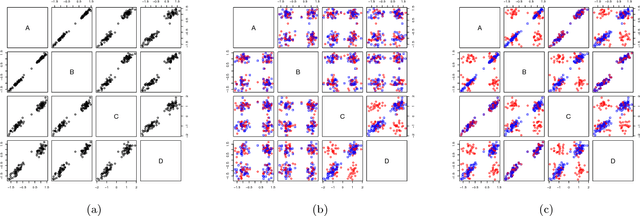
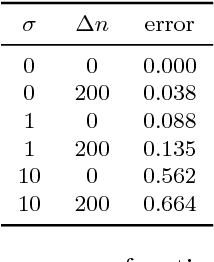
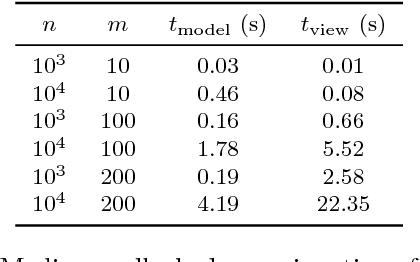
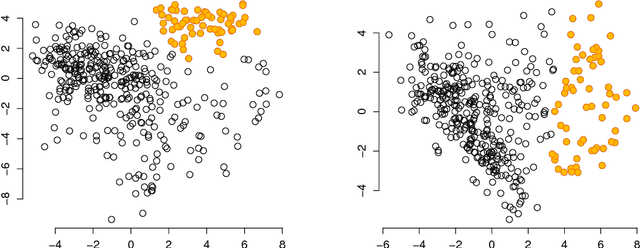
Abstract:An explorative data analysis system should be aware of what the user already knows and what the user wants to know of the data: otherwise the system cannot provide the user with the most informative and useful views of the data. We propose a principled way to do explorative data analysis, where the user's background knowledge is modeled by a distribution parametrised by subsets of rows and columns in the data, called tiles. The user can also use tiles to describe his or her interests concerning relations in the data. We provide a computationally efficient implementation of this concept based on constrained randomisation. This is used to model both the background knowledge and the user's information request and is a necessary prerequisite for any interactive system. Furthermore, we describe a novel linear projection pursuit method to find and show the views most informative to the user, which at the limit of no background knowledge and with generic objective reduces to PCA. We show that our method is robust under noise and fast enough for interactive use. We also show that the method gives understandable and useful results when analysing real-world data sets. We will release, under an open source license, a software library implementing the idea, including the experiments presented in this paper. We show that our method can outperform standard projection pursuit visualisation methods in exploration tasks. Our framework makes it possible to construct human-guided data exploration systems which are fast, powerful, and give results that are easy to comprehend.
 Add to Chrome
Add to Chrome Add to Firefox
Add to Firefox Add to Edge
Add to Edge